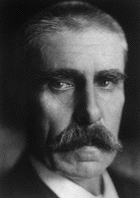

Julius
Wagner von Jauregg was born on March 7, 1857, in Wels, Austria. His father was a knight (Ritter) of the German
empire. He studied Medicine at Vienna University from 1874
to 1880, where he also studied with Salomon Stricker in the Institute of General and Experimental Pathology, obtaining
his doctor's degree in 1880. From 1883 to 1887 he worked with Leidesdorf in the Psychiatric Clinic, although his
original training was not in the pathology of the nervous system. In 1889 he suceeded the famous Richard von Krafft-Ebing
at the Neuro-Psychiatric Clinic of the University of Graz, and started his research on goitre, cretinism and iodine.
In 1893 he became Extraordinary Professor of Psychiatry and Nervous Diseases, and Director of the Clinic for Psychiatry
and Nervous Diseases in Vienna, as successor to Meynert. Ten years later, in 1902, Wagner-Jauregg moved to the
psychiatric clinic at the General Hospital and in 1911 he returned to his former post. The main work pursued by Wagner-Jauregg throughout
his life was related to the treatment
of mental disease by inducing a fever.
In 1887 he investigated the effects of febrile diseases on psychoses, making use of erisipella and tuberculin (discovered
in 1890 by Robert Koch).
Since these methods of treatment did not worked very well, he tried in 1917 the inoculation of malaria parasites,
which proved to be very successful in the case of dementia paralytica (also called general paresis), caused by
neurosyphillis. This discovery earned him the Nobel Prize in 1927. His main publication was a book titled "Verhütung und Behandlung der progressiven Paralyse
durch Impfmalaria (Prevention and
treatment of progressive paralysis by malaria inoculation) in the Memorial Volume of the Handbuch der experimentellen
Therapie, (1931). In 1928, Wagner-Jauregg retired from his post but
remained in good health and active until his death on September 27, 1940.

Julius Wagner von Jauregg
A Brief Biography
 To Know More
To Know More
From: The History of Shock Therapy in Psychiatry
By: Renato M.E. Sabbatini, PhD
Source: Brain & Mind Magazine, December 1997/March 1998